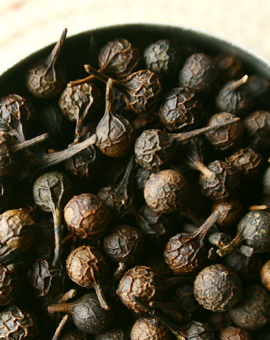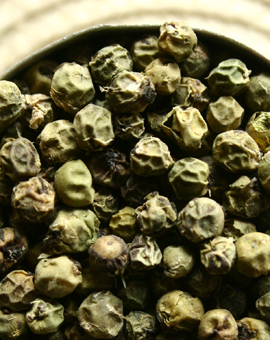 |


Ready to roast: chicken sprinkled with cayenne, known as “red pepper.” However, cayenne is a chile, not a red version of peppercorns. Photo by Agata Urbaniak | SXC. |
| WHAT IT IS: Varietal peppercorns—20 different pepper types and counting. |
WHY IT’S DIFFERENT: Each origin of the world produces pepper with different aromas and flavors—just like coffee beans and chocolate. |
| WHY WE LOVE IT: Another way to vary food accents—and it has no calories! |
| WHERE TO BUY IT: Pepper-Passion.com, Kalustyans.com. |
|
|
 |

Varietal Peppercorns:
Spice Up Your Life
Page 5: Pepper Glossary C & G
Varietal Pepper Glossary C To G
Cayenne Pepper. Cayenne is a hot red chile, a cultivar of the Capsicum annuum genus in the nightshade family (Solanaceae). See our Chile Glossary.
Chasteberry. See moula.
Cracked Pepper. Cracked pepper is partially broken peppercorns, that are crushed using a mortar and pestle. Because it has more flavor and texture than ground pepper, cracked pepper is used to coat steaks, chops and fish prior to cooking. It is also used in marinades, as a garnish and a seasoning, where a heavier pepper flavor is desired (the coarser the grain, the stronger the taste).
(The glossary continues below.) |
INDEX
This is Page 5 of an 11-page article. Click on the black links to visit other pages.
|
|
Cubeb Berry (or Tailed Pepper or Java Pepper). If you see what look like peppercorns with stems (tails) attached, you’re looking at cubeb, Piper cubeba, a cousin in the same family, Piperaceae, as Piper nigrum. Cultivated for its fruit and essential oil, it is grown on the Indonesian islands of Java and Sumatra. The fruits are gathered before they are ripe, and carefully dried. The dried, wrinkled fruit can be grayish-brown or black. The seed is hard, white and oily.
Cubebs are pleasantly aromatic; the taste is pepper-like with a refreshing anise quality and a long finish. Cubeb came to Europe via India through Venetian trade with the Arabs. It is one of the spices in ras el hanout, a popular blend of herbs and spices that originated in Morocco and is used in other parts of North Africa. During the Middle Ages, cubeb was one of the most valuable spices in Europe: It was ground as a seasoning for meat, used in sauces (Sauce Sarcenes was made of almond milk, cubeb and other spices) and candied whole as a confection. It might still be popular today, but was banned around 1640 by the King of Portugal, who had a vested interest in promoting the sale of Piper nigrum, which grew in Portuguese colonies.
Use It: In savory and sweet Moroccan dishes, in Indonesian gulés (curries), in stews, in marinades. The aromatic qualities of cubeb would pair well with cheese, meat and vegetable dishes; in spice mixtures such as quatre-épices for patés, sausages, gingerbreads and cookies; and in place of allspice. We love the quality of the cubeb berries in our sampler kit from Chef Stefan: we have been grinding them on fruit salads and look forward to using them in fruit sorbets.
|
|
 Cubeb Berries: exciting flavor for sweet and savory dishes. Photo by B.A. Van Sise | THE NIBBLE. ] Cubeb Berries: exciting flavor for sweet and savory dishes. Photo by B.A. Van Sise | THE NIBBLE. ]
|
Green Peppercorn. These are immature black Piper nigrum peppercorns, picked long before maturity while still unripe and actually green in color.
They are then steamed and quickly dehydrated, freeze-dried or pickled in brine to prevent fermentation. Because of the extra processing and the smaller yield, they tend to be more expensive; the freeze-dried version, which has superior appearance and flavor, is the most expensive. The corns are brightly aromatic with a piquant, fresh flavor, but are milder and fruitier, lacking the pungency of more mature black and white varieties of Piper nigrum. Green peppercorns offer a light, clean flavor and can be ground, but they are a softer peppercorn and are generally soaked and rubbed into the food, or added with their soaking liquid into a sauce.
Use In: Green peppercorns go especially well with very fresh or fruity-tasting foods and are frequently used in French, Creole, Thai and other Asian cuisines; they are the peppercorn used in a traditional pepper steak sauce. Try them ground on salads, steamed vegetables, salsas and in sauces. Use them in steak au poivre instead of the traditional black pepper, and mixed with black, white and pink peppercorns as a coating for seared tuna. Chef Trosch uses them in an olive oil marinade for shrimp. They are delicious with poultry, vegetables and seafood.
|
|
 Green Peppercorns: mild, fresh and fruity. Green Peppercorns: mild, fresh and fruity.
|
Grains Of Paradise (or Melegueta Pepper or Paradise Nuts or True Grains Of Paradise). Native to Ghana and Liberia in West Africa, Grains Of Paradise are related to cardamom; the seeds, or grains, of the plant are hot and spicy. See Melegueta Pepper for detailed information. There are numerous references in the literature to two different species for the “Grains of Paradise” spice, a.k.a. the Melegueta Pepper, that are cited by writers (including botanists and culinary authors). They are Aframomum melegueta and Aframomum granum paradisi, both of the family Zingiberaceae. However, the dozens of references to melegueta pepper we have read exactly describe the cardamom-like spice that is Aframomum melegueta: We have seen no description of a second type of spice. One old reference says that they are the same spice, that had been given different botanical names at different times. We’ll update this listing if we learn more. Current scholarship leans to Aframomum melegueta as the appropriate botanical name.
Continue To Page 6: Peppercorn Glossary H To L
Go To The Article Index Above
FOR ADDITIONAL INFORMATION, special offers,
contests, opinion surveys, THE NIBBLE
back issues archive, product gift-finder and more,
visit the home page of TheNibble.com.
Do you have friends who would enjoy THE NIBBLE?
Click here to send them an invitation to sign up for their own copy. |
ABOUT THE NIBBLE. THE NIBBLE™, Great Food Finds™, is an online magazine about specialty foods and the gourmet life. It is the only consumer publication and website that focuses on reviewing the best specialty foods and beverages, in every category. The magazine also covers tabletop items, gourmet housewares, and other areas of interest to people who love fine food.
© Copyright 2004-2025
Lifestyle Direct, Inc. All rights
reserved. All information contained herein is subject to change at any time
without notice. All details must be directly confirmed with manufacturers, service
establishments and other third parties. This material may not
be reproduced, distributed, transmitted, cached, or otherwise used, except with
the prior written permission of Lifestyle Direct, Inc.
|
 |
|
 |







